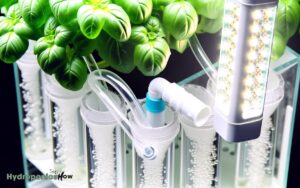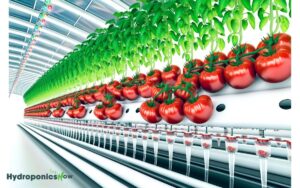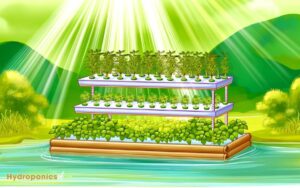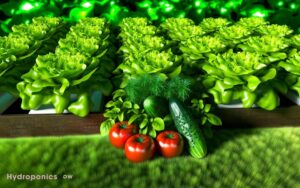Top 5 Hydroponic Systems for Cannabis: Best Choices Unveiled
Choosing the most suitable hydroponic system for cultivating weed hinges on understanding the specific advantages of each method.
Deep Water Culture (DWC) and Aeroponics are renowned for accelerating growth rates due to peak nutrient uptake and superior metabolic efficiency.
Nutrient Film Technique (NFT) and Ebb and Flow systems offer consistent nutrient and oxygen availability, fostering robust growth.
Drip Systems allow precise nutrient delivery, enhancing yield quality. While Wick Systems mitigate mechanical failures, making them ideal for small-scale novice growers, their nutrient uptake capacity limits their scalability.
For a detailed comparison of each system’s technical benefits and ideal applications, continue exploring further.

Key Takeaways
Deep Water Culture (DWC)
Deep Water Culture (DWC) is a hydroponic technique wherein plant roots are suspended directly into a nutrient-rich, oxygenated water solution, facilitating peak nutrient uptake and accelerated growth rates.
This method maximizes the availability of essential nutrients by maintaining constant contact between the root system and the nutrient solution.
Aeration, typically achieved using air stones and air pumps, is essential for preventing root hypoxia and ensuring ideal oxygen levels.
This results in increased metabolic activity and robust root development. DWC systems are noted for their simplicity and efficiency, allowing for precise control over pH levels and nutrient concentrations.
Such meticulous management of the growing environment leads to higher yields and faster growth cycles, making it particularly advantageous for cannabis cultivation.
Nutrient Film Technique (NFT)
Nutrient Film Technique (NFT) is a hydroponic method wherein a thin layer of nutrient-rich water continuously flows over the roots, providing a consistent supply of essential nutrients and oxygen to the plants.
This system employs a slight tilt in the growing channels, facilitating the gravitational flow of nutrient solution. The thin film guarantees that roots remain exposed to air at all times, enhancing oxygen uptake.
NFT is particularly advantageous for cannabis cultivation due to its efficient use of water and nutrients, and the rapid growth it supports.
However, it requires meticulous monitoring of nutrient concentration, pH levels, and water flow to prevent root drying or nutrient deficiencies, making it best suited for advanced growers with a high degree of technical proficiency.
Ebb and Flow
The Ebb and Flow system, also known as Flood and Drain, operates by periodically flooding the grow tray with nutrient solution and then allowing it to drain back into the reservoir, creating a dynamic environment for root oxygenation and nutrient uptake.
This cyclical flooding guarantees that cannabis roots receive ideal hydration and nutrients while preventing root rot by allowing ample oxygenation during the draining phase.
The system’s efficiency in delivering nutrients directly to the root zone enhances metabolic processes and accelerates growth.
Ebb and Flow systems are highly adaptable, easily scalable, and support various growing media, such as Rockwool, clay pellets, and perlite.
Additionally, the periodic flooding can be precisely controlled using timers, ensuring a highly customizable growing environment.
Aeroponics
Aeroponics represents a sophisticated hydroponic technique that greatly enhances root oxygenation, thereby optimizing plant respiration and overall growth.
This system employs a fine mist of nutrient solution, allowing for more efficient nutrient uptake compared to traditional methods.
Enhanced oxygen availability and nutrient efficiency collectively result in accelerated growth rates and higher yields for cannabis cultivation.
Root Oxygenation Benefits
Root oxygenation in aeroponic systems greatly enhances plant metabolic processes, leading to improved growth rates and higher yields. In aeroponics, roots are suspended in air and intermittently misted with nutrient-rich solutions, optimizing oxygen availability.
This elevated oxygen exposure stimulates root respiration, facilitating efficient uptake of water and essential nutrients.
Enhanced root respiration accelerates ATP production, essential for cellular activities and biomass accumulation.
Additionally, oxygen-rich environments reduce anaerobic conditions, decreasing the likelihood of pathogenic infections and root diseases. This optimized root zone aeration directly correlates with robust root development and vigorous plant growth.
Consequently, aeroponic systems offer substantial advantages in hydroponic cannabis cultivation by promoting superior metabolic efficiency and overall plant health. This method ensures optimal nutrient absorption by delivering a fine mist directly to the roots, reducing water and fertilizer waste. Additionally, aeroponic systems minimize the risk of soil-borne diseases, leading to healthier plants and higher yields. As a result, growing weed with hydroponics becomes more efficient and sustainable, making it an attractive choice for cultivators seeking maximum productivity.
Nutrient Efficiency Boost
In addition to the benefits of enhanced root oxygenation, the nutrient efficiency in aeroponic systems is markedly superior due to the precise delivery of nutrient solutions directly to the root zone.
This precision minimizes nutrient wastage and guarantees ideal uptake, enhancing plant growth and yield.
By atomizing the nutrient solution into fine mist particles, aeroponics maximizes the root surface area exposed to nutrients, thereby facilitating rapid absorption.
The controlled environment allows for the fine-tuning of nutrient concentrations, pH levels, and delivery intervals, creating an ideal growth medium.
This method greatly reduces the risk of nutrient imbalances and deficiencies often observed in traditional hydroponic systems, thus promoting consistent and vigorous plant development essential for high-quality cannabis cultivation.
Drip System
The drip system is a cornerstone in hydroponic cultivation. It enables precise and efficient nutrient delivery directly to the plant root zone, optimizing absorption rates and minimizing resource wastage.
This method’s inherent flexibility allows for tailored nutrient schedules and environmental controls. It fosters customizable growth conditions suited to the specific phenotypes of cannabis.
Consequently, the drip system’s adaptability and precision contribute greatly to enhanced yield quality and consistency.
Efficient Nutrient Delivery
Drip systems, known for their precision and efficiency, deliver nutrient-rich solutions directly to the plant roots, optimizing growth and minimizing waste. This system guarantees a continuous supply of essential nutrients, thereby facilitating robust plant development.
Key metrics for nutrient delivery in drip systems include flow rate, nutrient concentration, and delivery frequency. These parameters must be meticulously calibrated to maintain the best pH and electrical conductivity (EC) levels, critical for cannabis growth.
| Metric | Importance | Best Range |
|---|---|---|
| Flow Rate | Maintains consistent nutrient supply | 1-2 liters/hour |
| Nutrient Concentration | Prevents nutrient deficiencies | 800-1200 ppm |
| Delivery Frequency | Regulates nutrient uptake | 3-4 times/day |
| pH Level | Sustains nutrient availability | 5.5-6.5 |
| Electrical Conductivity (EC) | Indicates nutrient strength | 1.5-2.5 mS/cm |
Proper management of these variables enhances the efficiency and effectiveness of nutrient uptake.
Customizable Growth Conditions
Tailoring environmental parameters such as light intensity, humidity levels, and temperature within a drip system allows for precise control over the cannabis growth cycle, optimizing conditions for maximum yield and quality.
The drip system’s ability to deliver nutrients and water directly to the root zone ensures that plants receive consistent and ideal nutrition.
By customizing the irrigation schedule and nutrient composition, growers can fine-tune the vegetative and flowering phases. This precision minimizes stress factors and enhances photosynthetic efficiency.
Additionally, the closed-loop nature of a drip system reduces water waste and evaporation, making it both cost-effective and environmentally sustainable.
Employing sensors and automated controls further refines the environment, ensuring that plants thrive under ideal conditions.
Wick System
Utilizing capillary action, the wick system in hydroponics effectively delivers nutrient solution to plant roots without the need for pumps or complex machinery.
This system relies on passive transport mechanisms where absorbent wicks draw the nutrient solution from a reservoir to the grow medium, ensuring a continuous supply to the plant roots.
Ideal for small-scale cannabis cultivation, the wick system mitigates the risk of mechanical failure and reduces operational complexity.
However, it is less suitable for larger plants with higher nutrient demands due to limited nutrient uptake capacity. Peak performance is achieved through careful selection of wicking materials and precise monitoring of nutrient concentrations.
This method is particularly advantageous for novice growers due to its simplicity and cost-effectiveness.
Conclusion
In summation, the ideal hydroponic system for cannabis cultivation, much like selecting a chariot for a noble quest, depends on specific cultivation goals and resource availability.
Deep Water Culture and Nutrient Film Technique offer rapid growth akin to Icarus’s swift ascent, while Ebb and Flow, Aeroponics, Drip Systems, and Wick Systems provide versatility and efficiency.
Each method, bearing its own merits and challenges, requires careful consideration akin to an alchemist’s selection of elements for transmutation.






